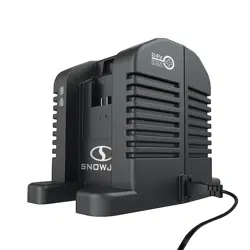
1
Model 24VCHRG-HS-DPC
QUICK GUIDE
24V LITHIUM-ION HIGH-SPEED
DUAL PORT CHARGER
R
R
© 2022 Snow Joe
®
, LLC
All rights reserved. Original instructions.
SAVE THESE INSTRUCTIONS
Form No. SJ-24VCHRG-HS-DPC-880E-M
EN
mWARNING! READ AND UNDERSTAND ALL INSTRUCTIONS. Failure to follow all
instructions listed below may result in electric shock, re and/or serious personal injury.
mCAUTION! To reduce the risk of injury, charge the 24V iON+ lithium-ion battery packs
only in its designated 24V iON+ lithium-ion charger. Other types of chargers present risk of re,
personal injury and damage. Do not wire a battery pack to a power supply plug or car cigarette
lighter. Such misuse will permanently disable or damage the battery packs.
• Avoid dangerous environments – Do not charge the battery packs in rain, snow or in
damp or wet locations. Do not use the battery packs or charger in the presence of explosive
atmospheres (gaseous fumes, dust or ammable materials) because sparks may be
generated when inserting or removing the battery pack, which could lead to a re.
• Charge in a well-ventilated area – Do not block the charger vents. Keep them clear to allow
for proper ventilation. Do not allow smoking or open ames near a charging battery pack.
Vented gases may explode.
NOTE: The safe temperature range for the batteries is 41°F – 105ºF (5°C – 40.5°C). Do not
charge the batteries outside in freezing weather; charge it at room temperature.
• Maintain charger cord – When unplugging the charger, pull the plug, not the cord, from
the receptacle to reduce the risk of damage to the electrical plug and cord. Never carry the
charger by its cord or yank it by the cord to disconnect it from the receptacle. Keep the cord
away from heat, oil and sharp edges. Make sure the cord will not be stepped on, tripped over
or subjected to damage or stress when the charger is in use. Do not use the charger with a
damaged cord or plug. Replace a damaged charger immediately.
• Do not use an extension cord unless it is absolutely necessary – Using the wrong,
damaged or improperly wired extension cord poses a risk of re and electric shock.
• Charger is rated for 120 volt AC only – The charger must be plugged into an appropriate
receptacle.
• Use only recommended attachments – Use of an attachment not recommended or sold by
the battery charger or battery pack manufacturer may result in risk of re, electric shock or
personal injury.
• Unplug charger when not in use – Make sure to remove the battery packs from
unplugged charger.
mWARNING! To reduce the risk of electric shock, always unplug the charger before
performing any cleaning or maintenance. Do not allow water to ow into the charger. Use a
Ground Fault Circuit Interrupter (GFCI) to reduce shock hazards.
• Store your charger in a cool, dry place – Do not store charger where temperatures may
exceed 105ºF (40.5ºC), such as in direct sunlight or inside a vehicle or metal building during
the summer.
Charge times vary. Refer to battery specications.
Charger Input ................................................................................................................. 400 – 480 W
Charger Output .................................................................................................................. 26V* Max
Net Weight ................................................................................................................. 3.5 lbs (1.6 kg)
*Initial no-load voltage, when fully charged, peaks at 26 volts; nominal voltage under typical load is 25.2 volts.
Battery Charge Level Indicator
Each battery pack is equipped with a push button for checking the charge level. Simply press the
push button to read o the battery charge level from the LEDs of the battery indicator:
• All 3 level monitoring LEDs are lit: Battery charge level is high.
• 2 level monitoring LEDs are lit: Battery charge level is decreasing. Stop work as
soon as possible.
• 1 level monitoring LED is lit: Battery is at. Stop work IMMEDIATELY and charge the battery.
Otherwise the battery’s service life will be greatly shortened.
When to Charge the iON+ Lithium-Ion Batteries
NOTE: The 24V iON+lithium-ion battery packs do not develop a “memory” when charged after
only a partial discharge. Therefore, it is not necessary to run down the battery pack before
connecting it with the charger.
• Use the battery charge indicator lights to determine when to charge your 24V iON+
lithium-ion battery packs.
• You can “top-o” your battery packs’ charge before starting a big job or after a
long day of use.
Charge the Battery
1. Press the push lock buttons on the battery to pull it out of the equipment.
2. Check that the mains voltage is the same as that marked on the rating plate of the battery
charger. Then, insert the charger’s plug into the electrical wall outlet. When you plug in the
charger, the top right green light will illuminate and stay green (Fig. 1).
3. Place the battery packs into the charger by sliding the packs to lock them into position.
When you insert the batteries into the charger, the top green light will go o, and the bottom
red light will illuminate to indicate that the batteries are charging (Fig. 2).
SAFETY INSTRUCTION
TECHNICAL DATA
OPERATION
Charge level button
The battery is at 30% capacity and requires charging
The battery is at 60% capacity and requires charging soon
The battery is at full capacity
Light IndicatorsLights
Fig. 1
Charger
green
Power on
Battery packs
Fully
Charged
green
Charging
red
Fig. 2
Loading ...
Loading ...
Loading ...
